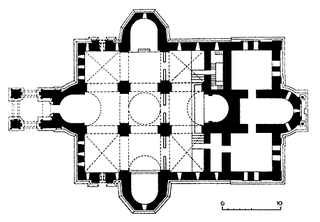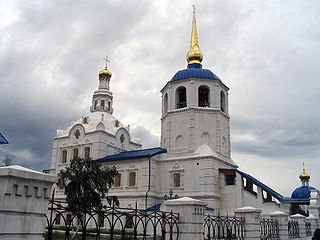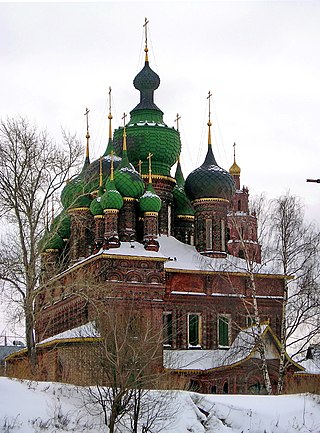
A spire is a tall, slender, pointed structure on top of a roof of a building or tower, especially at the summit of church steeples. A spire may have a square, circular, or polygonal plan, with a roughly conical or pyramidal shape. Spires are typically made of stonework or brickwork, or else of timber structures with metal cladding, ceramic tiling, roof shingles, or slates on the exterior.

Kizhi is an island near the geometrical center of Lake Onega in the Republic of Karelia, Russia. It is elongated from north to south and is about 6 kilometres (3.7 mi) long, 1 kilometre (0.62 mi) wide and is about 68 kilometres (42 mi) away from the capital of Karelia, Petrozavodsk.

Menshikov Tower, also known as the Church of Archangel Gabriel, is a Baroque Russian Orthodox Church in Basmanny District of Moscow, within the Boulevard Ring. The church was initially built in 1707 to order of Alexander Menshikov by Ivan Zarudny assisted by Domenico Trezzini, a team of Italian-Swiss craftsmen from Ticino and Fribourg cantons and Russian stonemasons from Kostroma and Yaroslavl. The earliest extant Petrine Baroque building in Moscow, Menshikov Tower was substantially altered in the 1770s. The church traditionally functioned in summer only; in winter the congregation assembled in nearby Church of Theodor Stratelates, built in 1782–1806. Church of Saint Theodore also provides the bells for ritual ringing: despite its height, Menshikov Tower does not have bells.

Naryshkin Baroque, also referred to as Moscow Baroque or Muscovite Baroque, is a particular style of Baroque architecture and decoration that was fashionable in Moscow from the late 17th century into the early 18th century. In the late 17th century, the Western European Baroque style of architecture combined with traditional Russian architecture to form this unique style. It is called Muscovite Baroque as it was originally only found within Moscow and the surrounding areas. It is more commonly referred to as Naryshkin Baroque, as the first church designed in this style was built on one of the Naryshkin family's estates.

A tented roof is a type of polygonal hipped roof with steeply pitched slopes rising to a peak. Tented roofs, a hallmark of medieval religious architecture, were widely used to cover churches with steep, conical roof structures.

Kizhi Pogost is a historical site dating from the 17th century on Kizhi island. The island is located on Lake Onega in the Republic of Karelia, Russia. The pogost is the area inside a fence which includes two large wooden churches and a bell-tower. The pogost is famous for its beauty and longevity, despite being built exclusively of wood. In 1990, it was included in the UNESCO list of World Heritage sites and in 1993 listed as a Russian Cultural Heritage site.

Church architecture refers to the architecture of Christian buildings, such as churches, chapels, convents, seminaries, etc. It has evolved over the two thousand years of the Christian religion, partly by innovation and partly by borrowing other architectural styles as well as responding to changing beliefs, practices and local traditions. From the Early Christianity to the present, the most significant objects of transformation for Christian architecture and design were the great churches of Byzantium, the Romanesque abbey churches, Gothic cathedrals and Renaissance basilicas with its emphasis on harmony. These large, often ornate and architecturally prestigious buildings were dominant features of the towns and countryside in which they stood. However, far more numerous were the parish churches in Christendom, the focus of Christian devotion in every town and village. While a few are counted as sublime works of architecture to equal the great cathedrals and churches, the majority developed along simpler lines, showing great regional diversity and often demonstrating local vernacular technology and decoration.

The Red Gate was a set of triumphal arches built in an exuberantly baroque design in Moscow. Gates and arches of this type were common in 18th century Moscow. However, the Red Gate was the only one that survived until the 20th century. It was demolished in 1927, but the name still survives in an eponymous Moscow Metro station.

Ukrainian Baroque, also known as Cossack Baroque or Mazepa Baroque, is an architectural style that was widespread in the Ukrainian lands in the 17th and 18th centuries. It was the result of a combination of local architectural traditions and European Baroque.

The architecture of Russia refers to the architecture of modern Russia as well as the architecture of both the original Kievan Rus', the Russian principalities, and Imperial Russia. Due to the geographical size of modern and Imperial Russia, it typically refers to architecture built in European Russia, as well as European influenced architecture in the conquered territories of the Empire.

St. Odigitrievsky Cathedral is an Orthodox church, a monument of architecture of the Siberian Baroque of the middle of the 18th century in Transbaikalia. It was built in 1741–1785 in the city of Verkhneudinsk

Carpathian Wooden Churches is the name of a UNESCO World Heritage Site that consists of nine wooden religious buildings constructed between the 16th and 18th centuries in eight different locations in Slovakia. They include two Roman Catholic, three Protestant and three Greek Catholic churches plus one belfry in Hronsek. In addition to these churches there are about 50 more wooden churches in the territory of present-day Slovakia mainly in the northern and eastern part of the Prešov Region.

Log buildings and structures can be categorized as historic and modern. A diverse selection of their forms and styles with examples of architectural elements is discussed in the following articles:

The Assumption or Dormition Cathedral was the main Orthodox church of Kharkiv until the construction of the Annunciation Cathedral in 1901. The cathedral stands on the University Hill by the bank of the Lopan River and dominates the entire downtown. The Neoclassical cathedral bell tower, built in the 1820s and 1830s to a height of 90 meters, remained the tallest building in the city until the 21st century. The cathedral is the only building in Kharkiv visited by almost all Emperors of Russia, starting with Catherine the Great.

Russian churches often have various recurrent elements in their architecture. The onion dome is for example a recurrent and important element in the architecture of Russian churches. Often Russian churches have also multi-colored filigree ornamental elements. Furthermore the colour white plays an important role in the style of Russian churches. In the past, Russian churches were made out of wood. Many Russian Orthodox churches are distinguished by their verticality, bright colors and multiple domes, which provide a striking contrast with the flat Russian landscape, often covered in snow. The first churches in Kievan Rus', such as the 13-domed wooden Cathedral of St. Sophia, Novgorod, differed in this regard from their mainly single-dome Byzantine predecessors. The number of domes was important symbolically. One dome symbolized the single God; three represented the Trinity, and five represented Christ and his four evangelists. At first the baptistery, narthex, and choir gallery above the narthex were a common feature of Rus' churches, but gradually they disappeared. After a century of Byzantine imitations, the Russian masons began to emphasise the verticality in church design.

Siberian Baroque is an architectural style common for ambitious structures in 18th-century Siberia, where 115 stone churches in Siberia were recorded in 1803, most of which were built in this provincial variant of the Russian Baroque, influenced by the Ukrainian Baroque and in some cases even incorporating lamaist motifs. Most of the buildings were preserved in Irkutsk, Tobolsk and Tomsk. An original interior of a Siberian Baroque structure survives only in the Feast of the Cross Church in Irkutsk.

The Rostov Kremlin is an architectural ensemble of four complexes, built during the 16th and 17th centuries in Rostov, Yaroslavl Oblast, Russia.

The Church of the Theotokos of the Sign (Dubrovitsy), or The Church of the Holy Sign of the Mother of God in Dubrovitsy, (Russian: Церковь Зна́мения Пресвятой Богоро́дицы в Дубровицах) is a Russian Orthodox church in the village of Dubrovitsy, Podolsk Urban Okrug, Moscow Oblast, Russia. Dubrovitsy is located about 36 km South of Moscow (16 km from the Moscow Ring Road; along the highway Podolsk-Dubrovitsy 6 km). The Dubrovitsy Estate used to belong to the noble families of Morozov, Golitsyn and Dmitriev-Mamonov. The estate consists of a palace, a Horse yard with Gothic gate, several outbuildings, a church and a park. The church is famous for its unique architecture, unusual to Russian architecture, as well as a mysterious history.

The Russian wooden architecture is a traditional architectural movement in Russia, that has stable and pronounced structural, technical, architectural and artistic features determined by wood as the main material. Sometimes this concept includes wooden buildings of professional architecture, eclectic buildings combining elements of folk architecture and professional architecture, as well as modern attempts to revive Old Russian carpentry traditions. It is one of the most original phenomena of Russian culture. It is widespread from the Kola Peninsula to the Central Zone, in the Urals and Siberia; a large number of monuments are located in the Russian North.




















